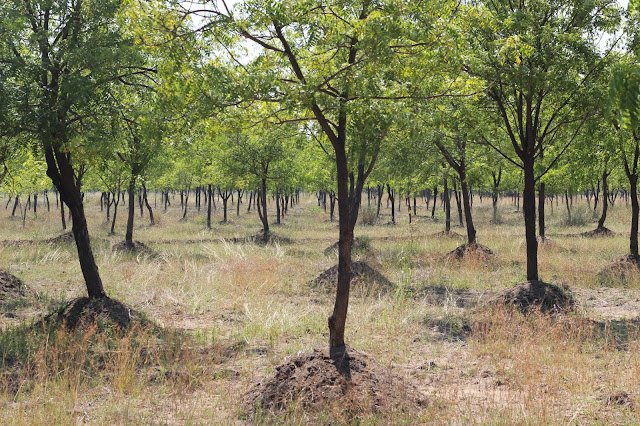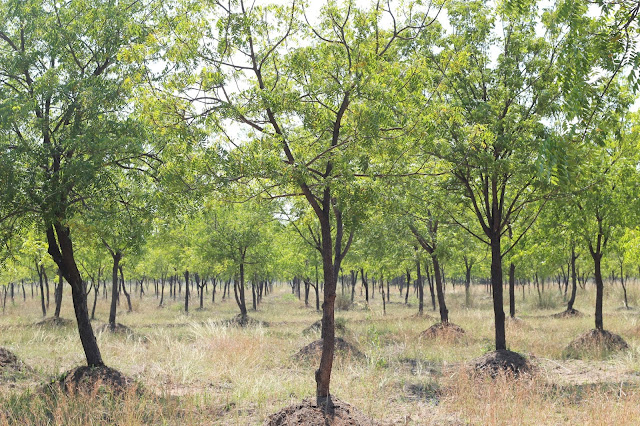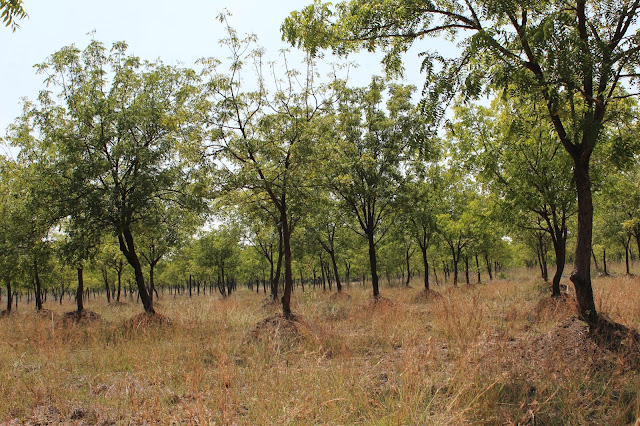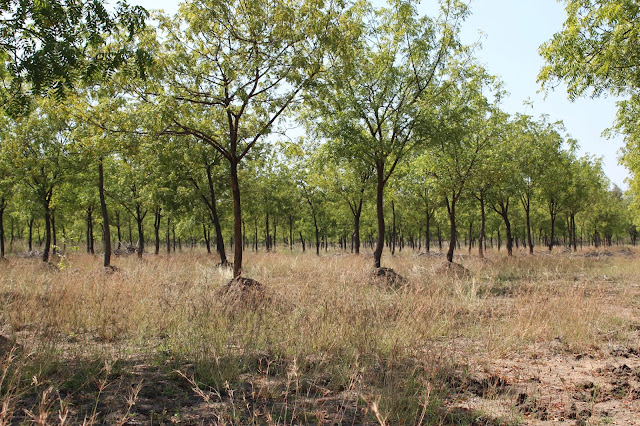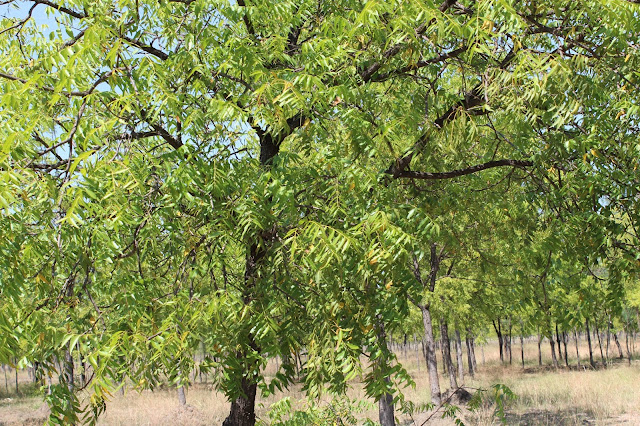1. Organic farming maintains the quality of the soil.
When a virgin field is tilled and then fertilized with synthetic fertilizers, it will lose between 50 and 65 percent of its nitrogen and soil carbon over fifty years. After that, increasing inputs of fertilizer — and thus of fossil fuel energy — will be needed to maintain yields. If that no longer pays, the land will be abandoned, becoming a wasteland on which little grows.
Organic farming has a different philosophy. It sees farmers as stewards of the land, harvesting its fruits while they care for it so that they can leave it to future generations in a condition as good as, or better than, it was when they started farming. So organic farmers maintain and enrich the soil by adding organic matter. That increases the number of worms and micro-organisms. Soil rich in organic matter needs less irrigation because the soil holds moisture better. It is also less likely to blow away in the wind, or wash off with every storm. A study of two adjacent wheat farms on similar soil near Spokane, Washington, found that over a 37-year period, the conventional farm lost more than 8 inches of topsoil, while the organic farm lost only 2 inches. The scientists concluded that the productivity of the organic farm was being maintained, while that of the conventional farm was being reduced because of high rates of soil erosion.
2. Organic farming fosters biodiversity.
The expansion of intensive modern agriculture, with its monoculture crops and intense use of pesticides and herbicides, threatens endangered species. Rare plants are indiscriminately sprayed with herbicides, along with more common weeds. Insecticides eliminate the prey of many birds, and small mammals may be poisoned too. Organic farms, in contrast, use no herbicides, fewer pesticides, have more organic matter in the soil, and tolerate hedges or other uncultivated areas. All this makes them a haven for endangered species of plants, insects, birds, and animals. In a survey of the evidence published in the journal Biological Conservation in 2005, scientists reviewed 76 separate studies comparing the impact of organic and conventional farms on such things as plants, soil microbes, earthworms, spiders, butterflies, beetles, birds, and mammals. They found that the majority of these studies demonstrated that the abundance and richness of species tends to be higher on organic farms. Significantly, the differences applied particularly to species that have experienced a decline because of the intensification of modern agriculture. In 2005, a five-year, government-funded study of British organic farms gave further support to that conclusion.
3. Organic farming reduces pollution from nitrogen run-off.
Conventional agriculture relies heavily on synthetic fertilizers, especially nitrogen. World-wide, the use of nitrogen as a fertilizer has increased tenfold in the last fifty years. Half to two-thirds of this nitrogen makes its way into rivers and other ecosystems, affecting both freshwater and marine environments. The most dramatic result is the dead zone in the Gulf of Mexico. Like the dead zone in Chesapeake Bay, the Gulf of Mexico dead zone is caused by too much nitrogen, but here the dominant source — 56 percent, according to the U.S. Geological Survey — is chemical fertilizer runoff rather than animal manure, which contributes 25 percent. The Gulf of Mexico dead zone has grown dramatically over the past twenty years, and when it peaks each summer, it now covers an area larger than the state of New Jersey. The peak comes a month after the spring use of nitrogen fertilizers in the Midwest Corn Belt — a month is the time it takes for the water from the Upper Mississippi to reach the Gulf. The expanding dead zone is disrupting fishing. This is only one of 146 dead zones around the world, and not even the largest — that is in the Baltic Sea. Nitrogen fertilizer runoff is largely responsible for most of these. Forty-three of the dead zones occur in U.S. coastal waters. A shift to organic farming, which does not use synthetic fertilizers, would dramatically reduce water pollution from nitrogen, and so shrink the dead zones.
4. Organic farming avoids the heavy pesticide and herbicide use typical of conventional farming.
Conventional farming relies heavily on pesticides, including insecticides and herbicides. Pesticide use per acre more than doubled between 1931 and 1997, although it has decreased slightly since then. During the 1990s, the U.S. Geological Survey collected more than 8,000 water and fish samples across the country and analyzed them for 76 different pesticides. Some key findings were:
- More than 90 percent of water and fish samples from all streams contained one, or more often several, pesticides.
- About half of all groundwater samples contained one or more pesticides.
- The highest rates of detection were for the most heavily used herbicides — atrazine, metolachlor, alachlor, and cyanazine — which were common in streams and shallow ground water in agricultural areas.
- Levels of any individual pesticide exceeding drinking water guidelines set by the Environmental Protection Agency were found in only 1 percent of samples, but there is uncertainty about the risks of low-level exposure to multiple pesticides. Moreover, for about half the pesticides detected the EPA has not set any guidelines.
- Close to half of the agricultural streams sampled had pesticide levels that exceeded Canadian guidelines for the protection of aquatic life. (The report referred to Canadian guidelines because there are no U.S. guidelines for this purpose.)
- Pesticides like DDT and Dieldrin, which have not been used since the 1960s, were still present across the country. DDT was found in almost every fish sample.
Organic farmers are permitted to use only a very limited range of insecticides, selected because they are natural products or their safety is well-established. Hence, organic farms will not, to the same extent as conventional farms, release insecticides into the air or nearby rivers. They are not permitted to use any herbicides at all.
5. Organic farming uses less energy for a given yield than conventional farming.
Organic farms do not use synthetic fertilizers, the manufacture of which requires a lot of energy. According to a study funded by the British Department for Environment, Food and Rural Affairs, organic crops used 35 percent less energy per unit of production and organic dairying 74 percent less. Scientists at the University of Essex found that organic farmers in a range of different countries required only 30 to 50 percent of the energy consumed in conventional farming systems.
6. Organic farming stores more carbon in the soil, thus off-setting carbon dioxide emissions.
Organic farming increases the amount of organic matter in the soil — matter that would otherwise rot above ground and produce carbon that would go into the atmosphere. So if organic farming spreads, that might reduce the severity of climate change. But how great an advantage organic farming has over conventional farming here is controversial. The Rodale Institute has carried out a 23-year study of the amount of carbon stored in the soil of its model farm and calculated that if the organic methods it uses were applied on all the cropland in the United States, 580 billion pounds of excess carbon dioxide could be sequestered in the soil every year. That’s about four times the quantity of emissions that would be saved if the fuel efficiency of all cars and light trucks on U.S. roads were doubled. But questions can be raised about how long annual carbon savings could continue, since eventually the organic matter will decompose and release carbon back into the atmosphere.
In any case, much depends on what forms of organic and conventional farming are compared. Organic farmers who use a lot of compost and animal manure and periodically grow cover crops and plow them into the soil will have much more carbon in the soil than farmers who use only synthetic fertilizers and till their soil, because tilling leads to a reduction in organic matter. But the rules for being certified “organic” in the U.S. do not require compost, manure, or cover crops. They simply make the use of such techniques more likely by banning most other methods of keeping the soil fertile. The ideal organic farmer who practices the methods used by the Rodale Institute is making a significant contribution to reducing the carbon build-up in the atmosphere, and the standard conventional farmer is not. Buying food labeled “organic,” however, does not guarantee that it was grown in keeping with the Rodale Institute methods.
There are two offsetting factors relative to climate change and organic farming to consider. It is often claimed that conventional farming produces higher yields per acre, on average, than organic farming. Therefore, if we need to produce a given quantity of food, we might use less land to produce it if we use conventional methods. Suppose we then took this extra land and planted it with trees, as part of an agro-forestry project. According to some estimates, trees absorb about eight times as much carbon per acre as soil can, even organically cultivated soil. That suggests an alternative strategy for storing carbon: grow the food we need by conventional methods on fewer acres, and plant trees on the rest. Of course, this presupposes that conventional farming really does produce higher yields than organic methods. The Rodale Institute conducted a 22-year comparative trial of conventional farming and organic farming. Although the yields from conventional farming were higher in the short-term, over the entire period of the trial, corn and soybean yields were just as high on fields farmed organically.
The second factor relative to global warming essentially concerns cows burping and farting. Cows produce methane, a greenhouse gas that is at least 20 times more potent than carbon dioxide and, overall, is responsible for about 2.5 percent of the total effect of greenhouse gas emissions. Cattle may be responsible for close to half of the world’s methane emissions. They produce more of it when they eat foods with a high fiber content, like grass or hay. Organic cows generally eat more grass and hay than non-organic cows. Moreover, organic cows do not get bovine growth hormone, or BGH, which increases a cow’s milk yields by about 10 percent. That means that you need 10 percent more organic cows to produce a given quantity of milk, and the extra cows will put more methane into the air.
